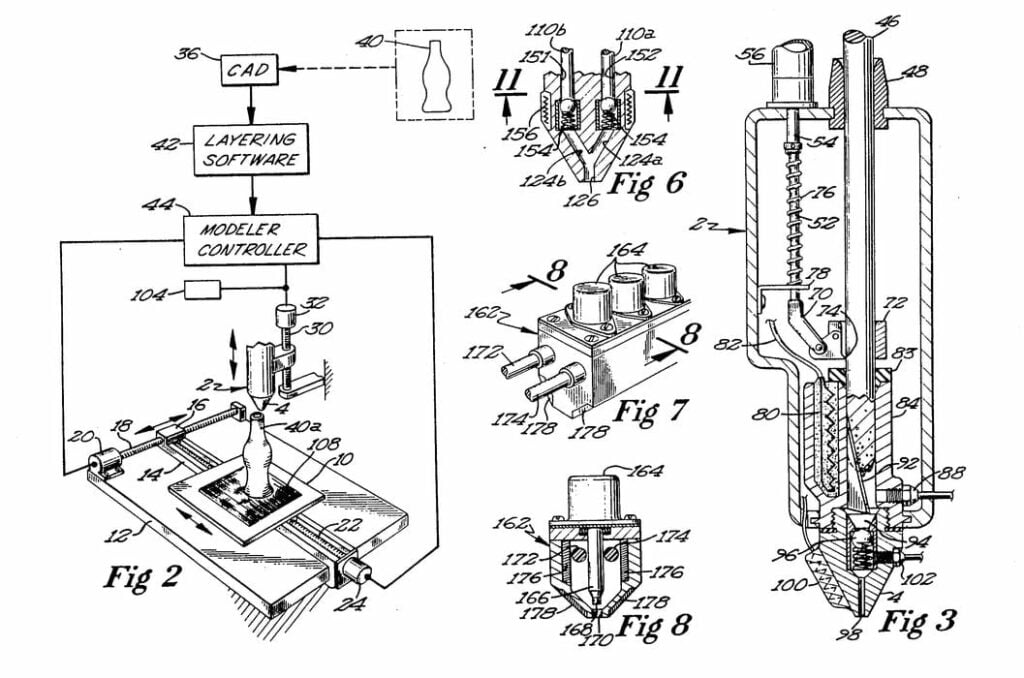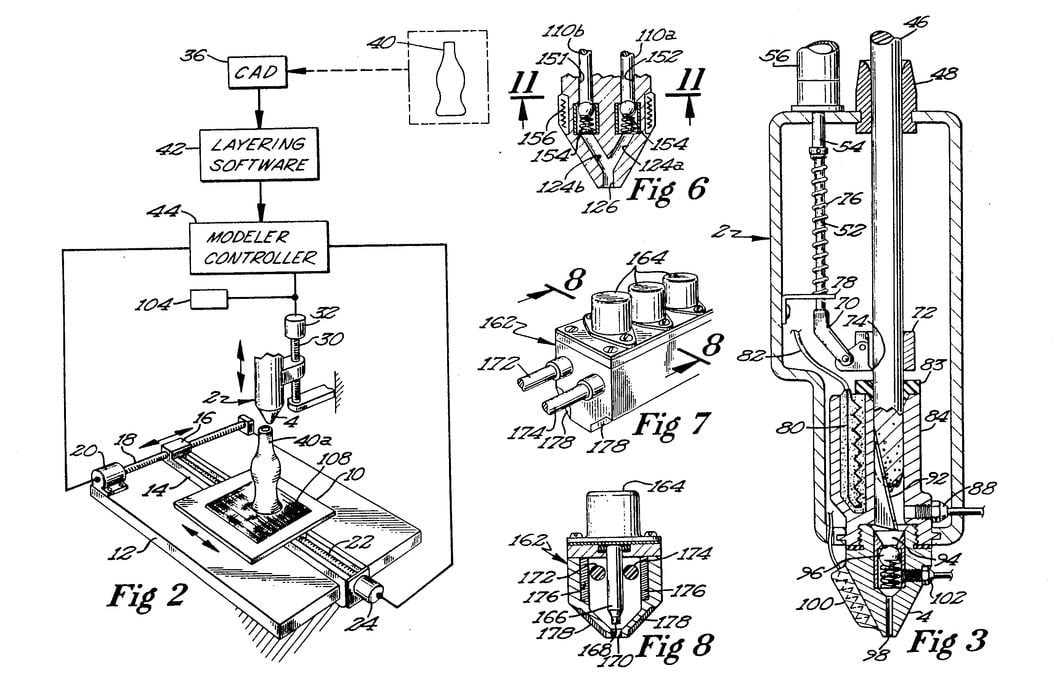
I was curious about the quantity of patents held by several 3D print companies, and decided to investigate.
Patents are legal mechanisms that allow a company to use a “method” exclusively for a limited time, which is typically 20 years. Often new innovations are created that, once protected by a patent, allow the inventor time and space to build a business around a new method.
Or that’s the intent. The reality is a bit different, where today’s existing companies tend to continually patent new methods, even if they aren’t ever intended on being used. This is done to block competitors and generally build an arsenal of legal assets for future use.
I did a very quick survey of selected 3D print companies to see what I could find regarding the amount of patents assigned to each.
However, I quickly realized this was not as easy as expected. There are a ton of issues, including:
- Some big conglomerates, like HP, GE, BASF or Ricoh, have billions of patents related to other technologies and it’s impossible to separate them to identify the 3D print-related patents
- Some companies, like Hitachi, hold many 3D print patents but they aren’t even in that business
- Patents are issued by country, and so we can find a single method having multiple patents in several jurisdictions: one method equals many patents
- Some older patents are actually expired. They are still in the databases, but cannot be enforced, and still belong to the owners, raising their totals
- Some companies have a hierarchy of corporate structure, where the patents are held elsewhere and not necessarily by the visible company; they are licensed intra-corporately for tax reasons and we don’t know how to find that company publicly
- Some companies have undergone mergers and acquisitions, and a patent being used by company A might be assigned to company B, which company A acquired 18 years ago, so it’s near impossible to keep track of all of them
You can see this is not necessarily an exact science.
Nevertheless, I drove ahead, selecting 93 likely suspects and obviously missing some others. I used the list of publicly traded companies we follow weekly in our “Who’s the Biggest” series, and added a bunch more. My search system provided me with counts of patents and even access to the patents, but as there are over 721,000 patents on this rough list, I wasn’t about to look at them all. But if you’d like to yourself, by all means proceed.
Here’s the sorted list:
| COMPANY | PATENTS |
| BASF | 537501 |
| Arkema | 49557 |
| Covestro | 33589 |
| Trumpf | 32621 |
| HP | 15262 |
| Renishaw | 12925 |
| EOS | 6940 |
| Stratasys | 5039 |
| 3D systems | 4786 |
| Hoganas | 3962 |
| XYZprinting | 3234 |
| voxeljet | 1965 |
| Materialise | 1881 |
| Jabil | 1604 |
| SLM Solutions | 1447 |
| ExOne | 1424 |
| Carbon | 963 |
| EnvisionTEC | 409 |
| XJET | 390 |
| Desktop Metal | 367 |
| Markforged | 358 |
| AddUp | 358 |
| Shining 3D | 351 |
| Farsoon | 332 |
| Formlabs | 306 |
| Thermwood Corporation | 303 |
| Aurora Labs | 226 |
| Optomec | 221 |
| Velo3d | 200 |
| Digital Metal | 188 |
| AMT | 177 |
| Impossible Objects | 165 |
| Creality | 164 |
| Massivit | 152 |
| Sindoh | 151 |
| Anycubic | 146 |
| 6K Additive | 128 |
| Sintratec | 127 |
| Nano Dimension | 123 |
| DyeMansion | 109 |
| Essentium | 103 |
| Nexa3D | 97 |
| Prodways | 94 |
| Flashforge | 89 |
| Shapeways | 74 |
| Inkbit | 69 |
| BigRep | 67 |
| Sigma Labs | 55 |
| Lithoz | 55 |
| Freemelt | 41 |
| 3DGence | 36 |
| Fathom | 35 |
| Mosaic Manufacturing | 31 |
| PostProcess Technologies | 21 |
| Meltio / Additech | 17 |
| INTAMSYS | 17 |
| Formalloy | 17 |
| Xact Metal | 10 |
| Roboze | 10 |
| Xometry | 9 |
| E3D | 9 |
| 3D Platform | 8 |
| Dyze Design | 8 |
| AML3D | 7 |
| Tethon 3D | 7 |
| Sinterit | 7 |
| Protolabs | 6 |
| MeaTech 3D | 5 |
| Raise3D | 4 |
| nTopology | 3 |
| Fusion3 | 2 |
| Fortify | 2 |
| Castor Technologies | 2 |
| Getech | 2 |
| Polymaker | 1 |
| Colorfabb | 1 |
| AON3D | 1 |
| JuggerBot 3D | 1 |
| MX3D | 1 |
| Fast Radius | 0 |
| Sygnis SA | 0 |
| Tinkerine | 0 |
| Prusa Research | 0 |
| Spee3D | 0 |
| Boston Microfabrication | 0 |
| 3DXtech | 0 |
| 3YOURMIND | 0 |
| Open Additive | 0 |
| BCN3D | 0 |
| Trilab | 0 |
| 3D Control Systems | 0 |
| Ulendo | 0 |
| WASP Srl | 0 |
Now let’s make some general observations, which is about all you can get from a messed up list such as this one.
First, there are a number of companies with few or even zero patents, at least as far as I could find. Perhaps I wasn’t looking in the right place, or using the assigned company name properly, so their count may be incorrect.
There are a few startup companies in that section and their few patents align with their key innovations. This makes sense, as this follows the original intent of patents to provide a means for the inventor.
Some companies that espouse the use of open source tools tend to have few or zero patents as well, which makes sense.
Topping the list were the several chemical companies I thought worthy of investigation. They alone comprise 86% of the total patents. There massive totals are most likely due to the patenting of individual chemical formulas for their countless products.
Below those at the top are a group of companies that, as I mentioned above, are involved in other technologies and have been around a while. Trumpf, HP and Renishaw are involved in multiple other technologies in addition to 3D printing. Further down, Hoganas could also be considered part of that group. On the other hand, Sindoh, a huge South Korean operation with multiple lines of business, apparently has relatively few patents assigned.
The interesting bits appear next on the list. EOS, Stratasys and 3D Systems are probably the “top” group when considering 3D print-related patents. This, in retrospect, is no surprise as they are also the oldest companies involved in the technology. They’ve had more time than most to develop patents, and apparently have been doing so for decades.
Most of the manufacturing companies we track because of their 3D print use appear somewhat lower on the list, and this is likely because they purchase technologies and use them, they don’t develop patentable technology themselves nearly as much. The exception might be Jabil, which has a strong count, suggesting they must be doing different things than their competitors.
Another group of relatively recent 3D print companies holds a middle ranking on the list, including companies like Carbon, Desktop Metal, XJET, Markforged, etc. I see these as similar to the top group, except that they haven’t been around as long and therefore haven’t produced as many patents.
XYZprinting has a surprising number of patents, far larger than I would have expected. While they are a subsidiary of Kinpo Group, a huge conglomerate, these patents are specifically assigned to XYZprinting and therefore are likely to be 3D print related.
What conclusions can we draw from this inaccurate but possibly representative list? I think there are two things to note.
First, it seems that in general, the older the company, the more patents they have. 3D print companies apparently tend to generate patents on a regular basis throughout their existence, not just when they launch. This is no doubt because they wish to mitigate the eventual expiry of their original patents by replacing them with younger patents that last a few more years.
Secondly, there are an awful lot of 3D print patents assigned. If we subtract out the chemical companies from the total, we still have a ridiculous 100,000 patents assigned.
Think about this: there are apparently at least 100,000 unique methods related to 3D printing. Can you list them? Can you list a dozen? What are all these methods? Surely some must overlap? How could a potential new invention be certified that it’s truly new? Would you have to look through 100,000 other patents?
Yes, you would. That’s why I suspect most don’t look through them and simply deal with conflicts later.
The clear and easy days of the initial 3D print patents are long since passed, and today it’s now an ocean of subtlety different methods that are of inconceivable number. Welcome to today’s 3D print patent world!
As for answering the question, which 3D print company really does have the most patents? I really don’t know, and I don’t think anyone else does, either.


